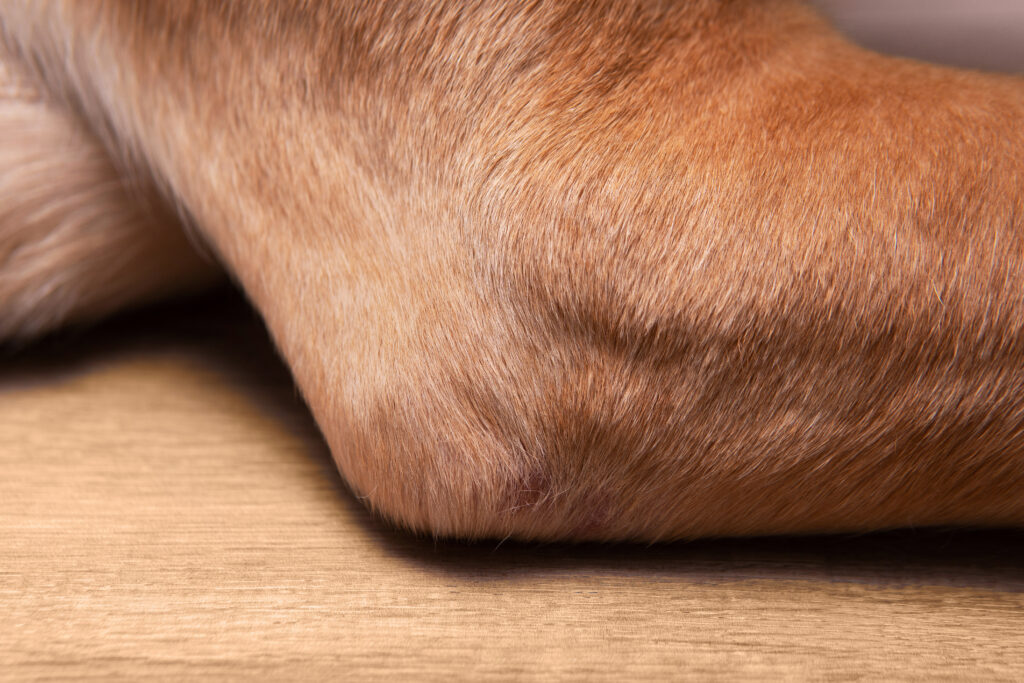Today, at North Jersey Animal Hospital in Wayne, NJ we’re focusing on a condition that can affect our canine companions: dog elbow dysplasia. This blog offers essential information about what elbow dysplasia is, its causes, symptoms, and the treatment options available. If you’re worried about your dog or need more information about this condition, feel free to give us a call at (973) 595-8600.
What is Dog Elbow Dysplasia?
Elbow dysplasia is a condition affecting the elbow joint in dogs, leading to discomfort and reduced mobility. It’s a common cause of lameness in the front limbs, particularly in larger breeds. The term “dysplasia” refers to the abnormal development of the elbow joint, where the bones do not fit together properly. This misalignment can lead to a range of issues including joint laxity, cartilage damage, and the development of osteoarthritis. Dogs with elbow dysplasia often experience a decrease in their quality of life due to pain and limited mobility. Understanding this condition is the first step in managing its impact on your pet’s health.
Causes of Elbow Dysplasia
Elbow dysplasia is primarily caused by genetic factors. Breeds such as Labradors, Golden Retrievers, and German Shepherds are more predisposed to this condition. However, environmental factors can also play a role. Rapid growth during the puppy stage, improper nutrition, and obesity can exacerbate the development of dysplasia. Ensuring a balanced diet and appropriate exercise during your dog’s growth phase can go a long way in preventing joint issues. Furthermore, routine wellness exams can help in identifying any early signs of joint problems, allowing for timely intervention.
Symptoms of Elbow Dysplasia in Dogs
The symptoms of elbow dysplasia can vary in intensity but typically include:
- Limping or Lameness: This is often the first sign of elbow dysplasia. Your dog may limp or walk with an uneven gait, especially after resting or during cold weather.
- Stiffness: Difficulty in getting up or reluctance to move can be a sign of joint discomfort.
- Pain: Your dog may express pain when the elbow is touched or moved.
- Swelling: The joint area may appear swollen due to inflammation.
- Reduced Activity: A decrease in willingness to play or exercise can indicate discomfort.
- Behavioral Changes: Some dogs may become irritable or withdrawn due to joint pain.
These symptoms can worsen over time if not addressed, so it’s important to monitor your dog’s behavior and physical condition regularly.
Diagnosing and Treating Dog Elbow Dysplasia
Diagnosing dog elbow dysplasia involves a combination of physical examination and diagnostic imaging. During the examination, we look for signs of pain, swelling, or abnormalities in the joint. Imaging tests like X-rays can confirm the diagnosis, showing the details of the joint structure. Advanced imaging techniques such as MRI or CT scans may be needed in complex cases to get a more comprehensive view of the joint.
Treatment Options
Treatment for elbow dysplasia is multifaceted and tailored to each dog. The main goals are to manage pain, maintain joint function, and slow the progression of arthritis.
Treatment options include:
- Medication: Non-steroidal anti-inflammatory drugs (NSAIDs) are often used to reduce inflammation and provide pain management for your dog.
- Physical Therapy: Customized exercise programs and therapies can help maintain joint mobility and muscle strength.
- Weight Management: Keeping your pet at a healthy weight reduces the load on the affected joint.
- Surgical Options: Various surgical techniques can be considered, especially for severe cases, to correct joint abnormalities or to alleviate pain.
- Supplements: Joint supplements containing glucosamine and chondroitin may be recommended by your vet to support joint health.
Prognosis and Outcomes for Dog Elbow Dysplasia Treatment
The long-term outlook for a dog with elbow dysplasia varies. Many dogs respond well to treatment and continue to live active lives. However, it’s important to understand that elbow dysplasia is a progressive condition. Ongoing management and regular physical exams are essential to keeping your dog comfortable and mobile.
By staying vigilant and addressing any signs of discomfort in your dog early, you can play a vital role in managing this condition effectively. If you think your dog might be showing early signs of elbow dysplasia, or if you have any concerns about their joint health in general, don’t hesitate to reach out to us at North Jersey Animal Hospital at (973) 595-8600 to schedule an appointment or to learn more about how we can help.





